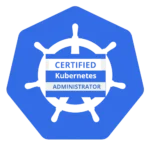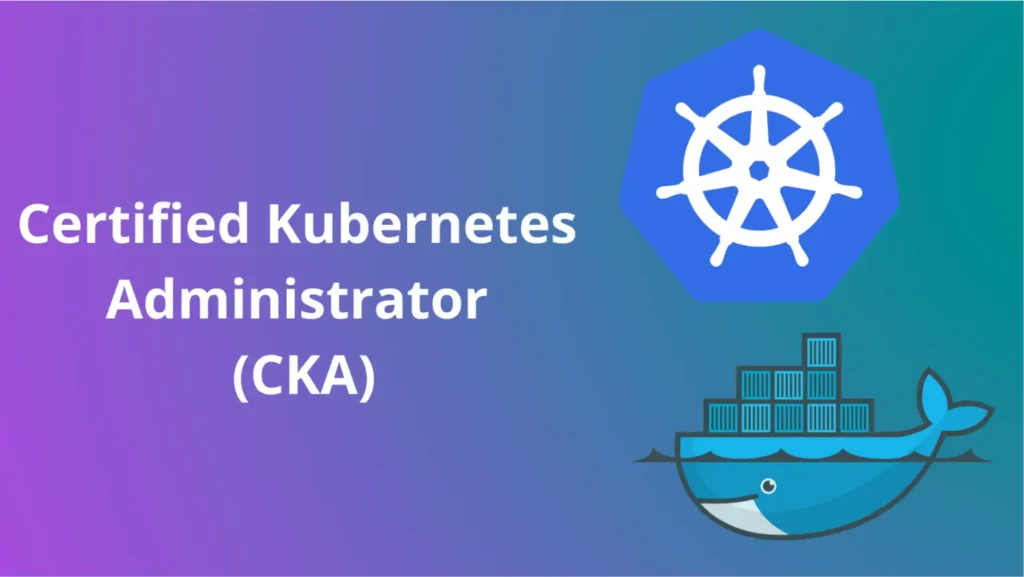Docker & Certified Kubernetes Administrator (CKA)
"The purpose of the Certified Kubernetes Administrator (CKA) program is to provide assurance that CKAs have the skills, knowledge, and competency to perform the responsibilities of Kubernetes administrators."
New Batch Starting In
Target Audience
- System Administrators
- DevOps Professionals
- Application Developers
- Kubernetes administrators,
- cloud administrators
- Other IT professionals who manage Kubernetes instances.

Exam Overview
Certification Name
Certified Kubernetes Administrator
Exam Duration
120 Minutes
Passing Score
66%
Certification Exam Code
CKA
Number of Questions
17
Exam fee
$395
Exam Languages
English,Japanese ,Korean and Simplified Chinese
Exam Format
Multiple Type. Multiple Answer Type Exam
Validity
3 years
Course Curriculum
Course Introduction
Certification
Certification Details
- Introducing Docker
- Comparing VM and Docker
- Docker –An Architectural overview
- The Docker Hub A brief Introduction
- Preparing docker-machine – Installation and configuration
- Start containerizing
- Play with docker images
- Customizing container on your own
- Running Container with Docker – commands
- Port forwarding with docker container
- Exercise: Installation of docker and Image Setup
- Exercise: Creating own Images
- Exercise: Creating own Images
- Exercise: Exposing Container Ports to the Host and test it
- Dockerfile Directives
- USER and RUN
- RUN Order of Execution
- ENV
- CMD vs. RUN
- ENTRYPOINT
- EXPOSE
- Docker Container Volume Management – An introduction
- Docker Networking concepts
- List and Inspect
- Create and Remove
- Assign to Containers
- Exercise: Creating a Custom Image from a Dockerfile
- Exercise: Managing Containers
- Exercise: Adding External Content to Containers
- Inspect Container Processes
- Previous Container Management
- Controlling Port Exposure on Containers
- Naming Our Containers
- Docker Events
- Managing and Removing Base Images
- Saving and Loading Docker Images
- Image History
- Taking Control of Our Tags
- Pushing to Docker Hub
- Exercise: Base Image Maintenance and Cleanup
- Exercise: Advanced Container Creation at the Command Line
- Exercise: Create a Dockerized Basic Web Server
- Continuous Integration for Docker
- Networking Overview
- The Default Network
- Isolating Containers
- Aliases & Container Names
- Links
- How Updates Affect Networking
- Using External Networks
- Configuring Compose
- Bringing an Environment Up
- Changing a Running Environment
- Taking an Environment Down
- Swarm Intro and Creating a 3-Node Swarm Cluster
- Swarm Mode A Built-In Orchestration
- Creating Your First Service and Scale It Locally
- Creating a 3-Node Swarm Cluster
- Swarm Basic Features and How to Use Them In Your Workflow
- Scaling Out with Overlay Networking
- Create A Multi-Service Multi-Node Web App
- Service Placement Preference
- Node Availability
Core Concepts Section Introduction
Cluster Architecture
ETCD for Beginners
ETCD in Kubernetes
ETCD – Commands
Kube API Server
Kube Controller Manager
Kube Scheduler
Kubelet
Kube Proxy
PODs
Practice Test Introduction
Solution – Pods (optional)
ReplicaSets
Practice Test – ReplicaSets
Deployments
Certification Tip!
Scheduling Section Introduction
Manual Scheduling
Practice Test Manual Scheduling
Solution: Manual Scheduling (optional)
Labels and Selectors
Practice Test Labels and Selectors
Solution: Labels and Selectors
Taints and Tolerations
Practice Test – Taints and Tolerations
Solution – Taints and Toleration (Optional)
Node Selectors
Node Affinity
Practice Test – Node Affinity
Solution – Node Affinity (Optional)
Taints and Tolerations vs Node Affinity
Resource Limits
Note on default resource requirements and limits
A quick note on editing PODs and Deployments
Practice Test Resource Limits
Solution: Resource Limits
Logging and Monitoring Section Introduction
Monitor Cluster Components
Practice Test Monitor Cluster Components
Solution: Monitor Cluster Components
Managing Application Logs
Practice Test Managing Application Logs
Solution: Logging : (Optional)
Download Presentation Deck 3
Application Lifecycle Management – Section Introduction
Rolling Updates and Rollbacks
Practice Test Rolling Updates and Rollbacks
Solution: Rolling update
Configure Applications
Commands and Arguments in Docker
Commands and Arguments in Kubernetes
Practice Test Commands and Arguments
Solution – Commands and Arguments (Optional)
Configure Environment Variables in Applications
Configure ConfigMaps in Applications
Practice Test Env Variables
Solution – Env Variables (Optional)
Secrets
Practice Test Secrets
Solution – Secrets (Optional)
A note on Secrets
Multi Container PODs
Practice Test – Multi Container PODs
Solution – Multi Container Pods (Optional)
Cluster Maintenance – Section Introduction
OS Upgrades
Practice Test OS Upgrades
Solution – OS Upgrades (optional)
Kubernetes Software Versions
References
Cluster Upgrade Introduction
Demo – Cluster upgrade
Practice Test Cluster Upgrade Process
Solution: Cluster Upgrade Process
Backup and Restore Methods
Working with ETCDCTL
Practice Test Backup and Restore Methods
Solution: Backup and Restore
Certification Exam Tip!
References
Download Presentation Deck 5
Feedback
Security – Section Introduction
Kubernetes Security Primitives
Authentication
Article on Setting up Basic Authentication
TLS Introduction
TLS Basics
TLS in Kubernetes
TLS in Kubernetes – Certificate Creation
lView Certificate Detais
Certificate Health Check Spreadsheet
Practice Test View Certificate Details
Certificates API
Practice Test Certificates API
KubeConfig
Practice Test KubeConfig
API Groups
Authorization
Role Based Access Controls
Practice Test Role Based Access Controls
Cluster Roles
Storage – Section Introduction
Introduction to Docker Storage
Storage in Docker
Volume Driver Plugins in Docker
Container Storage Interface
Volumes
Persistent Volumes
Persistent Volume Claims
Using PVC in PODs
Practice Test Persistent Volume Claims
Solution – Persistent Volumes and Persistent Volume Claims (optional)
Storage Class
Practice Test – Storage Class
Download Presentation Deck 7
Feedback
Networking Introduction
Prerequisite Switching, Routing, Gateways CNI in kubernetes
Prerequisite DNS
Prerequisite – CoreDNS
Prerequisite Network Namespaces
FAQ
Prerequisite Docker Networking
Prerequisite CNI
Cluster Networking
Important Note about CNI and CKA Exam
Practice Test – Explore Environment
Solution – Explore Environment (optional)
Pod Networking
CNI in kubernetes
CNI weave
Practice Test CNI weave
Solution – Explore CNI Weave (optional
Practice Test – Deploy Network Solution
Solution – Deploy Network Solution (optional)
ipam weave
Design a Kubernetes Cluster
Choosing Kubernetes Infrastructure
Configure High Availability
ETCD in HA
Important Update: Kubernetes the Hard Way
Download Presentation Deck 9
Introduction to Deployment with kubeadm
Resources
Deploy with Kubeadm – Provision VMs with Vagran
Demo – Deployment with Kubeadm
Practice Test – Deploy a Kubernetes Cluster using Kubeadm
Solution – Install a Kubernetes Cluster using kubeadm
Troubleshooting – Section Introduction
Application Failure
Practice Test Application Failure
Solution – Application Failure
Control Plane Failure
Practice Test Control Plane Failure
Solution: Control Plane Failure
Worker Node Failure
Practice Test Worker Node Failure
Solutions Worker Node Failure
Download Presentation Deck 10
Network Troubleshooting
Practice Test – Troubleshoot Network
Feedback
Instructor -led Kubernetes Training Live Online Class
Date
Time
Day
28th December 2025
5.00PM -09.00PM
Sunday
FAQ
What is the Certified Kubernetes Administrator (CKA) Certification?
The Certified Kubernetes Administrator (CKA) certification is designed to ensure that certification holders have the skills, knowledge, and competency to perform the responsibilities of Kubernetes Administrators
What are the Responsibilities of an Administrator?
A Certified Kubernetes Administrator can set up and maintain production-grade Kubernetes clusters, as well as do basic installation. They’ll understand important concepts such Kubernetes networking, security, storage,
troubleshooting, maintenance, logging and monitoring, application lifecycle, API object primitives, and determining fundamental end-user use-cases.
Is there any prerequisite for the exam?
There aren’t any mandatory prerequisites for the CKA exam.
How long will the exam take?
Candidates are allowed 2 hours to complete the CKA Exams.
What are the domains of the Certified Kubernetes Administrator exam?
The CKA exam is subdivided into the following major topics:
Storage 10%
Troubleshooting 30%
Workloads & Scheduling 15%
Cluster Architecture, Installation & Configuration 25%
Services & Networking 20%
How do I renew my certification?
Candidates have the option to retake and pass the exam to renew their certification. Certification Renewal must be completed prior to the certification expiration date.
The CKA renewed certification will be valid for a further 3 years effective from the date the exam is passed.
How many questions will be there in the CKA exam?
15-20 questions will be there.
What is the target audience for this exam?
The Certified Kubernetes Administrator (CKA) certification is designed for Kubernetes administrators, cloud administrators, and other IT professionals who manage Kubernetes instances.

